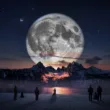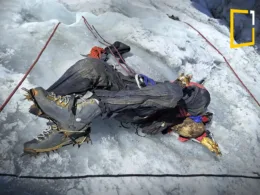Imagine standing on a vast white plain where the sky seems to fold into the earth. A place so surreal that reality feels like a dream. That’s Salar de Uyuni, the world’s largest salt flat, nestled high in the Bolivian Andes. Spanning more than 10,000 square kilometers, it’s an otherworldly spectacle that defies expectations and redefines beauty.
Looking for a fun, creative, and engaging way to keep your little ones entertained?

Our Digital Coloring & Activities Book is the ultimate solution! Packed with 26 pages of coloring pages, puzzles, mazes, games, and more, this printable PDF is designed to spark creativity and keep kids busy for hours.
👉 Get your’s now and make playtime unforgettable! Don’t wait – this deal won’t last forever! Use code onem50book and get 50% Off today! 🚀 🖍️ Let Your Kids’ Creativity Run Wild!
A Natural Wonder of South America
Formed from ancient lakes that have evaporated over time, Salar de Uyuni is not just a geographical feature—it’s a phenomenon. The endless expanse of salt looks like snow from afar, and during the rainy season, a thin layer of water transforms it into the world’s largest natural mirror.
Salar de Uyuni draws travelers from every corner of the globe, not just for its aesthetics but for the spiritual, almost cosmic experience it offers. It’s a place where photographers chase the perfect reflection, couples come for once-in-a-lifetime proposals, and adventurers feel like they’ve landed on another planet. Bolivia may not top every traveler’s bucket list, but this destination alone is enough to change that. Whether it’s your first time hearing about it or you’re already planning your trip, Salar de Uyuni is a marvel that will leave you speechless.
Geographic Location and Significance
Situated in southwest Bolivia, near the crest of the Andes at an altitude of about 3,656 meters (11,995 feet) above sea level, Salar de Uyuni occupies parts of the Potosí and Oruro departments. It’s part of the Altiplano, a high plateau surrounded by towering volcanoes and mountain ranges. The region is remote and rugged, but its isolation only adds to its mystical allure. Uyuni, the nearest town, serves as the primary gateway, offering basic amenities and launching points for multi-day tours across the flats and surrounding areas.
What makes this place even more intriguing is its role in the global ecosystem and economy. Beneath its shimmering crust lies a massive deposit of lithium—over 7% of the world’s known reserves—making it one of the most strategically valuable sites in the clean energy revolution. Despite its economic potential, the salt flat remains mostly untouched by commercial infrastructure, retaining its raw and unspoiled charm.
Salar de Uyuni also plays a crucial ecological role as a breeding ground for pink flamingos and a migratory stop for many bird species. It’s a living example of harmony between harsh natural conditions and delicate biodiversity. A visit here is more than a tour—it’s a journey into the heart of Earth’s silent and sacred beauty.
The Formation of Salar de Uyuni
Geological History and Evolution
To understand the breathtaking beauty of Salar de Uyuni, we need to go back—way back—over 30,000 years. The salt flat didn’t always exist as the gleaming white expanse we see today. In prehistoric times, much of the region was submerged under a massive lake known as Lake Minchin. This ancient lake eventually dried up, but in its place, it left behind smaller water bodies like Lake Poopó and Lake Uru Uru—and of course, the Salar de Uyuni.
The formation process is a fascinating mix of tectonic activity, volcanic eruptions, and climate shifts. The Andes Mountains rose dramatically due to the subduction of the Nazca Plate beneath the South American Plate, trapping water and forming large basins. Over time, evaporation intensified, especially in the arid, high-altitude climate. As the water vanished, it left behind thick layers of salt, gypsum, and other minerals—creating the flat, crusty white surface we see today.
But it’s not just a surface phenomenon. Beneath the salt crust lies a brine solution rich in lithium, potassium, and magnesium. These minerals continuously interact with the environment, reshaping the surface with subtle, natural artistry. Every polygonal salt pattern and ripple has a story of wind, sun, and time. In essence, Salar de Uyuni is a natural archive, telling tales of Earth’s ancient climate, geology, and evolution through its salty facade.
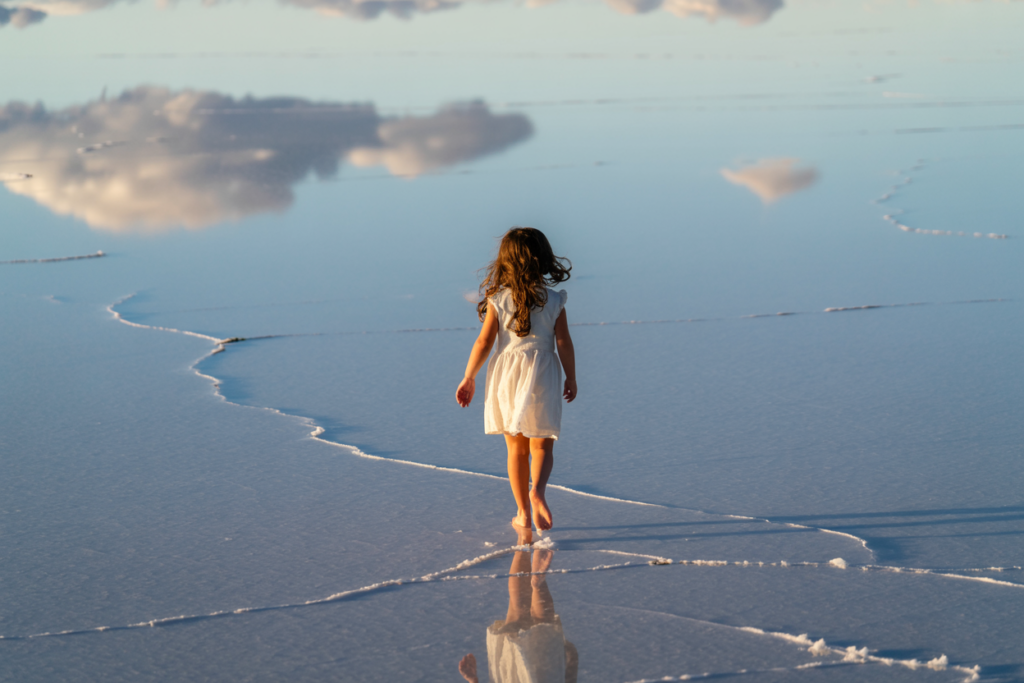
Transformation from Ancient Lakes
Lake Minchin wasn’t the only prehistoric lake that shaped the Uyuni region. After it evaporated, another smaller lake, Lake Tauca, filled the basin. This one lasted longer but eventually succumbed to the relentless aridity of the Andes. As Lake Tauca dried up, it left a concentrated residue of salts, which over thousands of years crystallized into the flats we see today.
Today, when visitors step onto the Salar, they are literally walking on a prehistoric lakebed—layers upon layers of geological history frozen in time. Some parts of the salt crust can be up to ten meters thick. And underneath that is a reservoir of lithium-rich brine that represents both promise and controversy in the world of green energy.
Geologists continue to study Salar de Uyuni not only to understand its past but also to monitor its role in the climate future. It’s more than just a visual marvel—it’s a geological miracle that spans millennia. Every step taken here is a walk through epochs, through transitions from liquid to solid, from lake to land, from forgotten past to a future of immense potential.
Salar de Uyuni’s Mesmerizing Mirror Effect
How the Mirror Illusion Works
If there’s one image that defines Salar de Uyuni in the public imagination, it’s that of the “Mirror of the Sky.” This isn’t a Photoshop trick or an Instagram filter—it’s a natural effect that occurs during the rainy season, typically between December and April. When a thin layer of rainwater covers the flat surface, it turns the salt flat into a giant, perfect mirror. The reflection is so flawless that it becomes nearly impossible to distinguish where the sky ends and the earth begins.
The science behind this illusion is simple yet fascinating. The flatness of Salar de Uyuni is unmatched—its elevation variation is less than one meter across its entire surface. Combine that with a high albedo (reflectivity) of the white salt crust and you have the perfect canvas for light to bounce off. When rainwater coats this surface, it amplifies the reflection, turning the landscape into an endless duality of sky and earth. It’s as if nature itself decided to paint a surrealist masterpiece.
Tourists often use this opportunity to create stunning optical illusion photographs—walking in the clouds, standing atop their reflections, or creating symmetrical panoramas that bend the mind. It’s a favorite for photographers, influencers, and filmmakers looking for the ultimate shot.
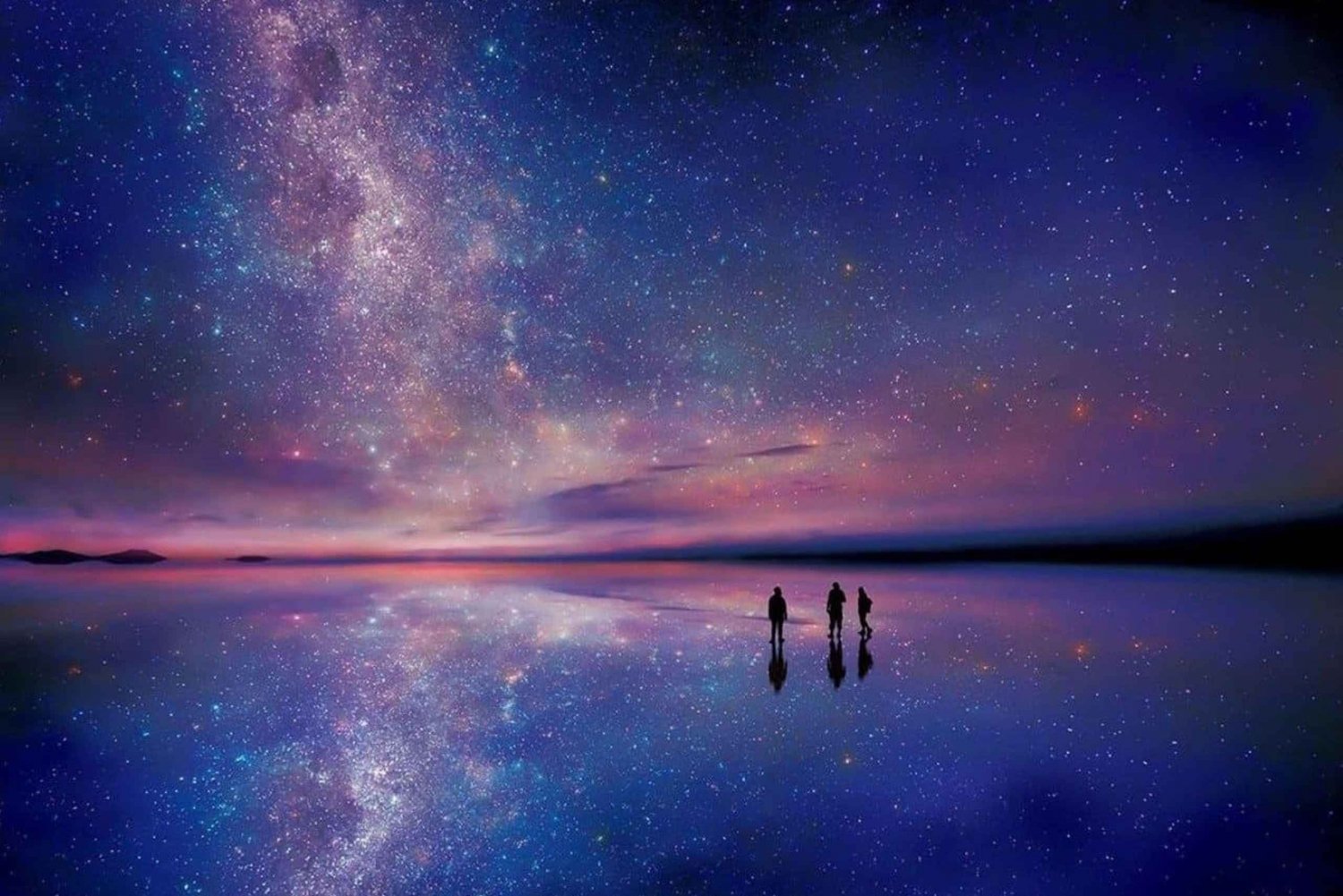
Best Time to Witness the Reflection
Timing your visit is crucial if you want to see the mirror effect in all its glory. The best months are typically from January to March, when the rainy season is in full swing. However, too much rain can flood the area, making some parts inaccessible, so it’s important to plan around weather forecasts and tour operator advice.
During the dry season (May to October), you won’t see the reflective surface, but you will experience the classic hexagonal salt patterns and dramatic sunsets. Both seasons offer unique experiences—one ethereal and dreamlike, the other stark and sculptural.
Want the best of both worlds? Visit in April or early May. This transition period sometimes offers the tail-end of the rains while revealing the salt crust beneath. It’s a narrow window, but it can reward you with unforgettable views.
Biodiversity and Wildlife in Salar de Uyuni
Flamingos and Other Avian Species
At first glance, Salar de Uyuni may appear lifeless—a stark white desert under the Bolivian sun. But beneath its seemingly inhospitable surface lies a surprising world of life. Most famously, Salar de Uyuni is home to three species of flamingos: the Chilean, Andean, and James’s flamingo. These vibrant pink birds come to the salt flats to breed, transforming parts of the landscape into scenes of graceful beauty.
The flamingos feed on microscopic algae that thrive in the mineral-rich waters of nearby lagoons. During breeding season, usually between November and January, thousands of flamingos gather in spectacular numbers, creating one of the most visually arresting scenes in South America. The contrast of their pink plumage against the dazzling white salt and deep blue skies is nothing short of magical.
Unique Flora and Fauna in Harsh Conditions
While Salar de Uyuni’s surface may seem barren, the surrounding areas are teeming with life uniquely adapted to the extreme environment. The harsh conditions—high altitude, intense UV radiation, drastic temperature shifts, and saline soils—create a challenging ecosystem, yet nature finds a way.
Around the salt flats, especially near the edges and islands like Incahuasi, you’ll find hardy plants such as giant cacti, known locally as Echinopsis atacamensis. These towering succulents can grow up to 10 meters tall and live for centuries. They thrive on the volcanic islands, where the terrain offers just enough nutrients and shelter from the salt. The sight of these massive cacti standing tall on an otherwise flat, white horizon adds to the surrealness of the landscape.
You might also encounter small mammals like viscachas (a rabbit-like rodent) and even foxes that roam the fringes. Birds, in addition to flamingos, include Andean geese, Andean avocets, and the majestic Andean condor, occasionally spotted soaring above the plateau.
The adaptability of these organisms is nothing short of miraculous. Many of them rely on saline lakes and microclimates created by geothermal vents or protected valleys to survive. These pockets of life act like oases, sustaining biodiversity in what otherwise seems like a frozen sea of salt. Scientists and ecologists study these adaptations as models for life in extreme environments—even drawing parallels with what might exist on Mars.
For travelers, this biodiversity enriches the experience. Salar de Uyuni isn’t just a backdrop for stunning photos; it’s a vibrant and living ecosystem waiting to be appreciated by those willing to look a little closer.

Cultural and Historical Significance
Indigenous Communities and Their Traditions
Long before Salar de Uyuni became a tourist sensation, it was a sacred and integral part of life for the indigenous peoples of the Andes, particularly the Aymara and Quechua communities. These groups have lived in the region for centuries, coexisting with the harsh landscape through deep respect and sustainable practices.
For these indigenous communities, the salt flat is more than just a physical space—it’s a living entity. Many believe that Salar de Uyuni holds spiritual significance, a sacred link between the heavens and the Earth. Ancient rituals, passed down through generations, are still practiced today. Ceremonies dedicated to Pachamama (Mother Earth) often involve offerings like coca leaves, alcohol, and sweets, symbolizing gratitude for the resources and protection she provides.
Salt extraction is also a cultural tradition. For generations, families have harvested salt manually using wooden tools and ancestral techniques. This is not only an economic activity but a cultural expression of resilience and harmony with nature. Salt blocks from Uyuni are used for consumption, trade, and even construction—some hotels in the area are entirely made from salt bricks.
Despite the encroaching influence of tourism, many indigenous people have maintained their cultural identity and now engage in the industry as tour guides, artisans, and hospitality workers. They offer visitors a chance to experience Salar de Uyuni through their eyes—rooted in history, respect, and community.
Visitors who engage respectfully with these communities often find the human connection just as memorable as the landscape itself. It’s a reminder that while Salar de Uyuni feels like another planet, it is very much a part of human life and heritage.
Myths, Legends, and Local Beliefs
Like many awe-inspiring places, Salar de Uyuni is steeped in folklore. One of the most captivating local legends tells the story of the mountains surrounding the flats—Tunupa, Kusku, and Kusina. According to Aymara mythology, these mountains were once living giants.
Tunupa, a powerful goddess, was betrayed by her husband Kusku, who left her for Kusina. Heartbroken, Tunupa’s tears and milk flooded the plain, forming what we now know as Salar de Uyuni. This tale not only gives cultural context but also explains the salt and water that make the flats so unique.
These myths are not mere stories; they’re deeply woven into the fabric of local identity. They serve as metaphors for the harsh yet beautiful realities of life in the Andes—loss, endurance, and the cyclical nature of nature.
Travelers who learn these legends gain a richer understanding of the salt flats. It becomes more than a natural wonder—it becomes a landscape filled with stories, emotions, and ancestral memory. These beliefs continue to influence local practices, from agricultural calendars to spiritual ceremonies, reinforcing the idea that Salar de Uyuni is as much a cultural phenomenon as it is a geological one.
The Salt Economy of Salar de Uyuni
Traditional Salt Harvesting
Salar de Uyuni is one of the largest sources of salt on Earth, with an estimated 10 billion tons covering its surface. But unlike many industrial-scale operations around the world, salt harvesting here still retains a largely manual, artisanal approach, especially in areas operated by local communities.
Early each morning, you’ll see workers equipped with simple tools—picks, shovels, and wooden molds—gathering salt into small conical piles. These mounds are left to dry under the intense Andean sun before being collected. Some of the salt is used for consumption, some for livestock, and some is shaped into blocks used in construction and tourism.
The process is physically demanding and not particularly lucrative, yet it continues because it is deeply rooted in tradition. In many cases, families pass down salt harvesting knowledge like heirlooms, preserving both a livelihood and a way of life.
Travelers can visit these salt-harvesting areas and even participate in the process. Some tours include a stop at Colchani, a small village where you can watch salt being processed and buy locally made salt-based souvenirs. These might not be high-end luxury goods, but they carry with them the authenticity and spirit of Salar de Uyuni.
What stands out most about traditional salt harvesting is its sustainable nature. Without heavy machinery or environmental disruption, it represents a model of resource extraction that respects nature and supports local communities.

Lithium Reserves and Global Importance
Beneath Salar de Uyuni’s gleaming crust lies a treasure trove of lithium—the soft, silvery-white metal essential for batteries that power everything from smartphones to electric vehicles. The salt flat holds one of the world’s largest untapped lithium reserves, making Bolivia a key player in the global clean energy race.
The lithium is found in brine trapped below the salt crust. Extracting it involves pumping the brine to the surface, allowing the water to evaporate, and then isolating the lithium compounds. While the economic potential is immense, the process is not without controversy. Environmentalists raise concerns about water usage, contamination, and disruption to the fragile ecosystem.
The Bolivian government has long tried to manage lithium extraction through state control and partnerships that emphasize local benefit over foreign profit. However, debates continue over how to balance environmental protection, indigenous rights, and economic development.
For visitors, this aspect of Salar de Uyuni adds a new layer of relevance. It’s not just a breathtaking landscape; it’s a symbol of the 21st century’s challenges and opportunities—how to transition to clean energy without repeating the mistakes of the past.
Exploring the salt flats with this context in mind reveals the deeper story beneath your feet. Salar de Uyuni is not just a spectacle; it’s a crucible where tradition, technology, and the future intersect.
The Experience of Visiting Salar de Uyuni
Tour Options and Itineraries
Visiting Salar de Uyuni isn’t your average day trip—it’s an immersive adventure that unfolds over vast distances and diverse terrains. Most visitors start from the town of Uyuni, where countless tour operators offer options ranging from one-day excursions to multi-day expeditions that cover the salt flats and surrounding highlands.
One-day tours are ideal if you’re short on time. These usually include stops at the Train Graveyard, Colchani village, the salt flats, and Incahuasi Island. But to truly absorb the majesty of this region, a 3-day tour is the way to go. These longer journeys take you beyond the salt crust to colorful lagoons, smoking geysers, and surreal rock formations in the Eduardo Avaroa National Reserve.
Many tours offer overnight stays in salt hotels—yes, hotels made entirely from salt bricks, complete with salt beds and salt dining tables. Others offer stargazing sessions in the middle of the salt flats, where the Milky Way stretches from horizon to horizon.
It’s crucial to choose a reputable tour company, preferably one with English-speaking guides and a focus on sustainability. Prices vary depending on group size, duration, and amenities. Private tours are more comfortable and flexible, while shared tours are budget-friendly and sociable.
No matter which option you choose, a tour to Salar de Uyuni is not just a checklist item—it’s a transformational journey. Each stop feels like a scene from a different planet, stitched together by the surreal beauty of Bolivia’s high-altitude deserts.
Staying Overnight on the Salt Flats
One of the most unique experiences in Salar de Uyuni is spending the night on or near the salt flats. There are salt hotels built with walls, furniture, and floors made entirely from compressed salt blocks. These hotels are more than just a gimmick—they offer cozy, unforgettable stays that connect you to the environment in the most tangible way.
Imagine waking up in a room of salt, stepping outside to a sunrise that sets the sky ablaze, and watching the mirror-like surface reflect the cosmos at night. These salt hotels are often located just outside the flats to preserve the environment but still offer stunning views.
Accommodations range from basic lodges to luxury eco-resorts that provide gourmet meals, hot showers, and heated rooms—an important feature in the freezing Andean nights. Make sure to book in advance, especially during peak season (December to April).
Some tours also offer wild camping options. This isn’t for the faint-hearted, but it rewards the adventurous with total immersion in nature. Picture this: no light pollution, just you, the stars, and the silence of a million-year-old salt desert.
Must-See Attractions Near Salar de Uyuni
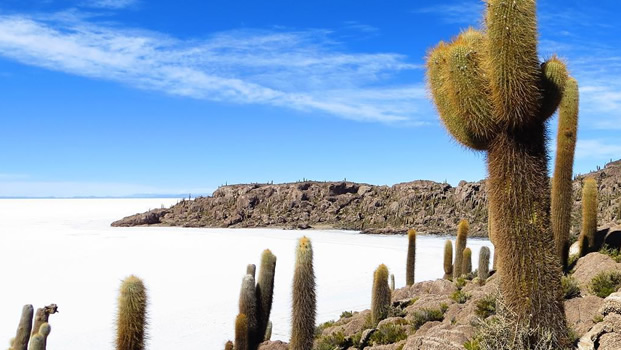
Incahuasi Island and Its Giant Cacti
Right in the middle of the seemingly endless white plains of Salar de Uyuni lies a geological anomaly—Incahuasi Island, also known as the “Island of the Inca House.” This rocky, cactus-covered outcrop looks like it was plucked from a distant desert and dropped into a sea of salt. It’s not just a quirky pitstop; it’s one of the most captivating attractions on the salt flats.
Incahuasi is a former coral reef that now serves as a rugged island oasis. Its name derives from the Quechua language, meaning “Inca house,” reflecting the deep cultural ties to the land. The island is covered in hundreds of giant cacti, some over 10 meters tall and estimated to be more than a thousand years old. These ancient plants stand like sentinels, offering a stunning contrast to the pristine, white flatlands that surround them.
Visitors can hike along designated trails that wind around the island, offering panoramic views of the salt flats from elevated vantage points. It’s one of the few places where you can gain perspective on just how vast and flat Salar de Uyuni truly is. The walk is relatively short but steep, so take it slow, especially due to the high altitude.
Photographers will find Incahuasi a dream come true. The cacti, the salt, the skies—it’s an irresistible combination. Make sure to bring enough water, wear sunscreen, and charge your camera. This island may be small, but it’s packed with jaw-dropping views and quiet moments that will stay with you forever.
Eduardo Avaroa Andean Fauna National Reserve
Just south of Salar de Uyuni lies another of Bolivia’s natural wonders: Reserva Nacional de Fauna Andina Eduardo Avaroa. This high-altitude reserve spans over 7,000 square kilometers and offers one of the most surreal landscapes on Earth. If you’re on a multi-day tour from Uyuni, this reserve is likely included—and trust us, you’ll want to see it.
The reserve is famous for its otherworldly lagoons. There’s the Laguna Colorada, a red-hued lake colored by algae and mineral sediments. It’s dotted with flamingos, creating a visual that seems more like a painting than real life. Then there’s Laguna Verde, a green-tinted lake set against the backdrop of the Licancabur Volcano. Each lagoon has its own unique mineral composition, causing dramatic and vivid color variations that change with the sun.
Beyond the lagoons, the reserve features steaming geysers, hot springs, and bizarre rock formations like the Arbol de Piedra (Stone Tree), a wind-sculpted formation that looks like it belongs on Mars. The stark beauty of this region is matched only by its biodiversity—home to rare wildlife including vicuñas, Andean foxes, and the elusive Andean cat.
Due to its remote location and high altitude (some areas exceed 5,000 meters), visiting Eduardo Avaroa requires preparation. Bring warm clothing, snacks, and altitude sickness medication. Tours typically include meals and lodging in rustic accommodations, but the reward is an intimate connection with nature unlike anything else.
Photography and Stargazing Opportunities
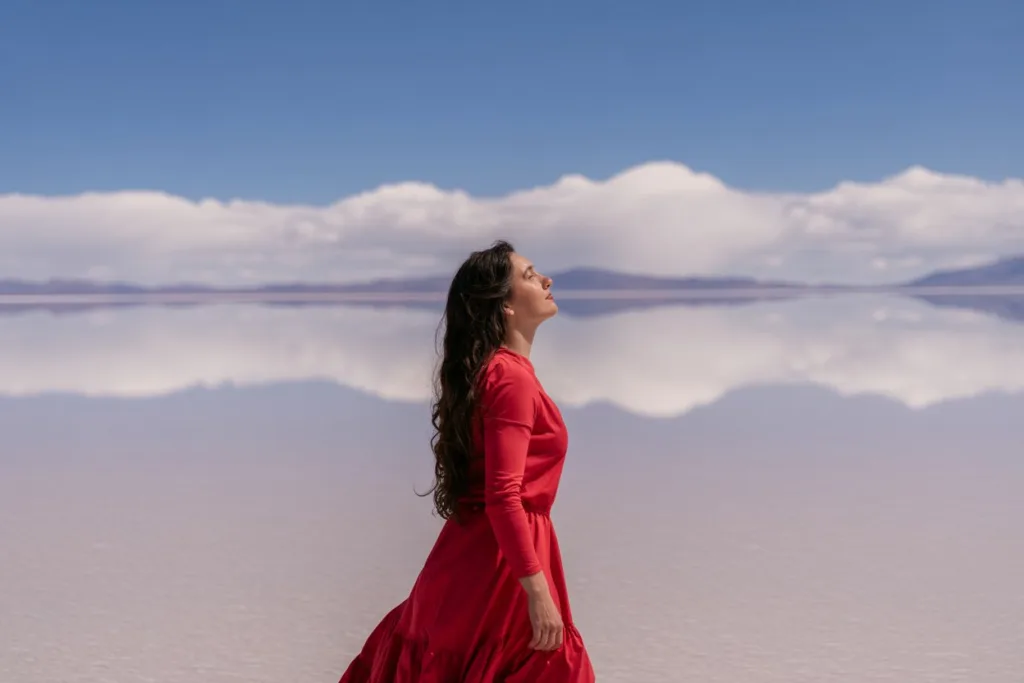
Capturing the Perfect Shot
If you’re even remotely interested in photography, Salar de Uyuni is your dream destination. The salt flats are a playground of visual illusions and endless creative possibilities. Whether you’re an amateur snapping with your smartphone or a seasoned pro with a DSLR, there’s something magical to capture at every turn.
During the rainy season, the reflective surface creates mesmerizing symmetrical shots. You can play with perspective, creating illusions where people appear to be walking on water or standing on the sky. The dry season is no less dramatic—the polygonal salt patterns, stretching uniformly into the horizon, offer a unique texture that adds drama to your frames.
Sunrises and sunsets are particularly spectacular. The low angle of the sun paints the flats in hues of pink, orange, and gold. Use this golden hour to capture wide landscapes, silhouetted subjects, or close-ups of the salt crust that glows under the changing light.
To make the most of your photography experience:
- Bring extra batteries (the cold drains them fast).
- Use wide-angle lenses for landscape shots.
- A tripod is essential for night or low-light shots.
- Experiment with reflections and human scale for illusions.
Night Skies and Astrophotography
When night falls over Salar de Uyuni, a different kind of magic begins. Thanks to its high altitude and lack of light pollution, the salt flats offer some of the best stargazing conditions in the world. On a clear night, the sky becomes a celestial ocean, with stars twinkling in every direction and the Milky Way stretched across the heavens.
Astrophotography here is unlike any other location. During the rainy season, the mirrored surface reflects the starry sky, making it appear as though you are standing in the middle of space. It’s an almost transcendental experience—perfect for long exposures and time-lapse videos.
For the best stargazing:
- Avoid full moon nights to maximize visibility.
- Dress very warmly—temperatures plummet at night.
- Book a private night tour or stay overnight on the flats.
- Bring a flashlight with a red filter to preserve night vision.
This isn’t just a travel photo opportunity—it’s a once-in-a-lifetime chance to see our universe from one of Earth’s most surreal vantage points. For many, this is the highlight of their entire journey through Bolivia.
Challenges and Precautions for Travelers
Adapting to Altitude and Weather
Salar de Uyuni sits at nearly 3,700 meters (over 12,000 feet) above sea level, and many surrounding attractions are even higher. If you’re not used to high altitudes, you may experience altitude sickness, also known as soroche. Symptoms can include headaches, nausea, fatigue, and shortness of breath.
To mitigate these effects:
- Acclimate in La Paz or another high-altitude city before heading to Uyuni.
- Drink plenty of water.
- Avoid alcohol and heavy meals.
- Coca tea or coca leaves, widely available in Bolivia, can help with symptoms.
- Consider altitude pills like acetazolamide (consult your doctor before use).
The weather is another factor. Days can be sunny and warm, but nights are bone-chillingly cold, especially in winter (June–August). The sun at altitude is fierce—UV exposure is intense even when it’s cloudy.
Packing essentials include:
- Layers of clothing (thermal base layers, fleece, windproof jacket).
- Sunglasses with UV protection.
- Lip balm and sunscreen.
- Moisturizer (the air is very dry).
Safety and Environmental Considerations
Salar de Uyuni is a remote area with limited infrastructure, so safety requires a bit of preparation. While most tours are safe and reputable, incidents can happen—especially with reckless drivers or poorly maintained vehicles. Always choose licensed, experienced tour operators with strong reviews and working radios or GPS.
If you’re self-driving (not recommended for first-timers), bring:
- Extra fuel and water.
- A satellite phone or GPS device.
- A paper map (cell service is unreliable).
- Knowledge of the terrain and emergency protocols.
Environmental responsibility is also key. Salar de Uyuni is delicate—both ecologically and culturally. Don’t litter, damage salt patterns, or disrupt wildlife. Avoid off-road driving in sensitive areas, and support eco-conscious businesses that prioritize conservation.
Traveling responsibly ensures that this natural wonder remains pristine for generations to come. Salar de Uyuni is more than a destination—it’s a privilege to experience.
Sustainable Tourism and Conservation Efforts
Protecting Fragile Ecosystems
While Salar de Uyuni appears tough and unchanging, its ecosystem is surprisingly delicate. The increase in tourism, unregulated lithium extraction, and climate change all pose significant threats to its fragile balance. Protecting this natural wonder isn’t just the responsibility of governments and organizations—it requires a collective effort from every traveler who steps onto its salt-crusted surface.
The flora and fauna around Salar de Uyuni, particularly the flamingo populations and microalgae in the surrounding lakes, are extremely sensitive to changes in water chemistry and temperature. Polluted runoff from mining operations or improperly disposed waste from tourists can disrupt this balance quickly. Even the tire marks left behind by off-road vehicles can scar the surface for years.
In response, Bolivia has enacted laws and conservation policies to protect the salt flats and surrounding reserves. Some areas are off-limits to vehicles, and others are only accessible through guided tours with certified operators. Local NGOs and community groups also participate in education, preservation, and clean-up campaigns.
Travelers can contribute by minimizing waste, avoiding plastic, sticking to designated paths, and choosing eco-conscious tour operators. Even small actions—like bringing a reusable water bottle or respecting local customs—can make a significant difference. Salar de Uyuni deserves to be preserved not just for its visual splendor but for the ecosystems and cultures that depend on it.
Responsible Travel Tips
To be a responsible traveler in Salar de Uyuni, follow these sustainable tourism practices:
- Pack in, pack out: Don’t leave any waste behind. Carry a bag to collect your trash, including tissues and food wrappers.
- Respect wildlife: Don’t feed, chase, or touch animals. Observe from a respectful distance.
- Stay on trails: Stick to paths and designated vehicle tracks to avoid damaging the salt crust and surrounding terrain.
- Use eco-lodging: Book hotels and tours that follow green practices, such as solar power, water recycling, and community support.
- Support local artisans: Buy souvenirs from indigenous communities to help sustain traditional crafts and livelihoods.
- Be culturally aware: Learn a few phrases in Spanish or Quechua, ask before taking photos of people, and participate in cultural experiences respectfully.
By adopting a thoughtful, mindful approach to travel, you help ensure that Salar de Uyuni remains a destination of awe and inspiration for centuries to come.
Salar de Uyuni in Pop Culture
Iconic Appearances in Films and Media
Salar de Uyuni’s surreal landscape hasn’t gone unnoticed by the global entertainment industry. Its ethereal beauty has become a popular filming location for movies, documentaries, and music videos that aim to portray otherworldly or futuristic settings. One of its most high-profile appearances was in the 2017 film Star Wars: The Last Jedi, where it stood in as the mineral planet Crait. The salt-covered battlefield, where white salt is scraped away to reveal red mineral underneath, was directly inspired by Uyuni’s contrasting layers.
In addition to blockbuster films, Salar de Uyuni has also featured in countless travel documentaries by National Geographic, the BBC, and Discovery Channel. These programs often highlight the region’s geological significance, biodiversity, and cultural heritage, further amplifying its allure.
Music videos and fashion shoots have also embraced the location for its visual impact. Its blank canvas makes colors, motion, and subjects pop in an almost supernatural way. Even video games like Gran Turismo 6 and travel campaigns by tourism boards use Salar de Uyuni as a visual anchor for bold, immersive storytelling.
These appearances in media contribute to its mystique and global recognition, making it not just a travel destination, but a cultural icon. Every exposure adds another layer to its legend, drawing in travelers, artists, and dreamers from all walks of life.
Artistic Interpretations and Inspirations
Beyond film and photography, Salar de Uyuni serves as a muse for countless artists, writers, and musicians. Painters interpret its vastness as a metaphor for freedom or solitude. Poets write of its ability to dissolve the boundary between heaven and Earth. Musicians compose ambient tracks that reflect its stillness and echoing silence.
Some local artists even use salt from the flats to craft sculptures, mosaics, and functional items. These creations aren’t just souvenirs—they’re expressions of a deep connection with the land. Street murals in Uyuni town often depict local legends and the salt harvest, turning walls into storytelling canvases.
Travelers themselves become artists here. Whether capturing images, journaling their journey, or simply reflecting on the surreal beauty, each visitor contributes to the creative spirit that Salar de Uyuni inspires. It’s a place where imagination runs free and creativity is boundless.
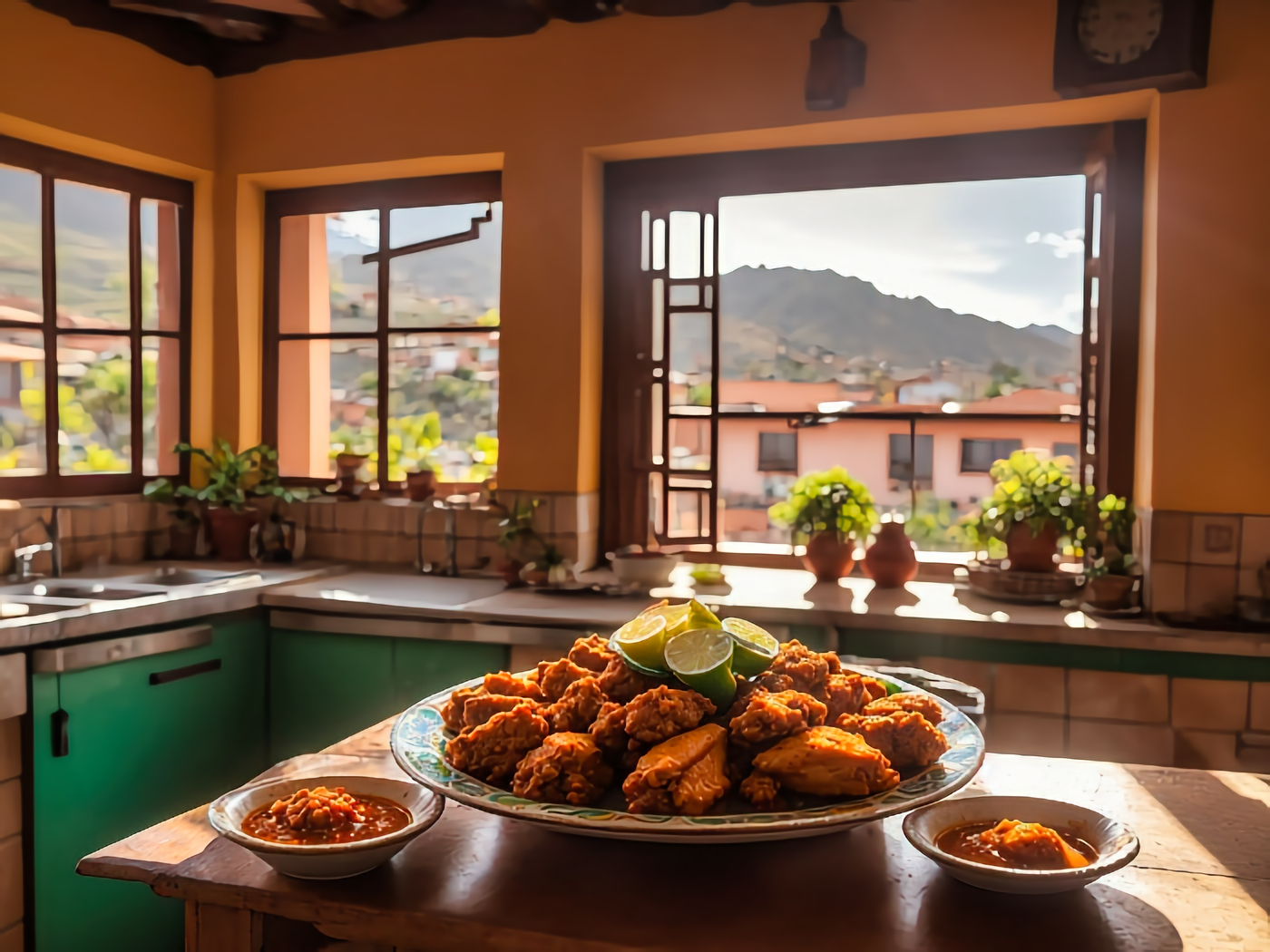
Local Cuisine and Gastronomic Delights
Bolivian Dishes to Try While Visiting
Traveling through Bolivia isn’t just a feast for the eyes—it’s a literal feast. While Uyuni may be remote, it offers a rich taste of Andean cuisine that’s both hearty and flavorful. Local ingredients like quinoa, llama meat, corn, and potatoes dominate the menu, often prepared with simple yet satisfying techniques passed down through generations.
One must-try dish is salteñas, savory pastries filled with spiced meat, potatoes, and a slightly sweet broth. They’re Bolivia’s answer to empanadas and make a perfect breakfast before a day out on the flats.
Llama steak is another highlight. Don’t be put off by the idea—llama meat is lean, nutritious, and commonly eaten in Bolivia. When grilled and served with Andean potatoes or chuño (freeze-dried potatoes), it makes for a deliciously local experience.
Vegetarians need not worry. Dishes like sopa de quinoa (quinoa soup) and ají de lentejas (spicy lentil stew) are widely available and flavorful. Plus, the locals often go out of their way to accommodate dietary preferences, especially in tour groups.
Drinks like mate de coca (coca leaf tea) not only warm you up but also help with altitude sickness. And for something stronger, try singani, Bolivia’s national liquor, often mixed with lemon and soda for a refreshing cocktail.
Dining Experiences on the Salt Flats
If you’re lucky, your tour might include a picnic or dinner set up right on the salt flats. These meals, especially at sunset or under the stars, are a highlight of many travelers’ trips. Imagine sitting at a salt table, eating quinoa salad, grilled vegetables, and sipping wine while the horizon glows pink and orange. It’s rustic luxury at its finest.
Some luxury tours even offer full-service al fresco dining with table settings, chefs, and candlelight in the middle of the flats. It’s the kind of experience you’d expect in a five-star restaurant—only your dining room is the Bolivian sky.
Whether you’re grabbing a quick bite in Uyuni town or feasting under the Milky Way, the culinary offerings of this region add a flavorful note to an already unforgettable journey.
Planning Your Trip to Salar de Uyuni
How to Get There
Despite its remote location, getting to Salar de Uyuni is easier than you might think. Most travelers arrive via Uyuni, the gateway town that serves as the starting point for most salt flat tours. There are several ways to reach Uyuni:
- By Air: The fastest and most convenient option is flying from La Paz to Uyuni. Multiple daily flights take about an hour and offer incredible views of the Andes.
- By Bus: Overnight buses from La Paz, Sucre, or Potosí are budget-friendly options. Buses are generally comfortable, but the roads can be bumpy, and travel time is long—about 10 to 12 hours.
- By Train: From Oruro, you can take a scenic train ride to Uyuni, operated by Ferroviaria Andina. It’s slower but offers a more authentic travel experience.
If you’re coming from Chile, particularly from San Pedro de Atacama, you can book multi-day tours that end in Uyuni. These usually pass through the Eduardo Avaroa Reserve and offer stunning routes through high-altitude deserts.
Once in Uyuni, it’s easy to find tours, guides, and accommodations. Booking in advance is recommended during peak season, but walk-in options are often available year-round.
Packing Essentials and Travel Tips
Packing for Salar de Uyuni is all about versatility. You’ll be experiencing high-altitude sun, freezing nights, and possibly wet conditions if you visit during the rainy season.
Essentials include:
- Layers of warm clothing (thermal base layers, a down jacket, gloves, and a beanie).
- UV sunglasses and high-SPF sunscreen.
- Moisturizer and lip balm (the dry air is brutal).
- Sturdy waterproof shoes or boots.
- A refillable water bottle and snacks.
- Camera gear and portable chargers.
- Altitude medication and personal toiletries.
Always carry some cash in Bolivianos, as card payments are rare in remote areas. Also, be respectful of local customs—ask before taking photos of people, and always follow your guide’s advice.
Conclusion
Salar de Uyuni is more than a destination—it’s a revelation. A place where Earth and sky blur into one, where myths live in mountains, and where salt can build cities and fuel the future. Whether you come for the photos, the science, the culture, or simply to stand in awe of nature’s artistry, this Bolivian marvel will leave an indelible mark on your soul.
From its surreal reflections and ancient geology to its vibrant wildlife and rich traditions, Salar de Uyuni is a landscape that demands both reverence and preservation. It’s a reminder that the most extraordinary places often lie far from the beaten path—and those who venture there are forever changed.
So pack your bags, bring your curiosity, and get ready to touch the sky where it meets the Earth.
Love those amazing creatures?
If you’re fascinated by beavers, check out our exclusive “Exclusive & Awesome” t-shirt — perfect for nature lovers, engineers geeks, and anyone who appreciates Earth’s incredible animals!

Etsy store : https://etsy.me/4jSK5iW
OneMinute Shop : https://bit.ly/beavertshirt
👉 Shop Now
—————————————————————
Thanks for joining this wild ride. Stay curious, stay tuned, and let’s make our world brighter!
Subscribe to our channel and stay tuned for more intriguing mysteries and scientific wonders. Together, let’s uncover the secrets of the Earth and expand our understanding of this fascinating world.
Check out the latest blog and video on YouTube and learn something new today.
Attention, all readers! To deepen your understanding and stay informed on the latest news and trends, be sure to click on the link to access more informative articles.
Join the family by liking us on Facebook, or follow us on Twitter and Instagram.
If you liked this story, sign up for the weekly OneMinuteExplore features newsletter called “The Essential List”. A handpicked selection of stories from OneMinute Nature, Wildlife, Culture, Travel, Stories, and more… delivered to your inbox every Weekend.
👉 We may earn a commission from purchases made through links in this content, but it won’t affect your price. Rest assured, our recommendations are based on thorough research and genuine belief in the products. Your support through these links helps us continue providing valuable content. Thank you for being so supportive!




